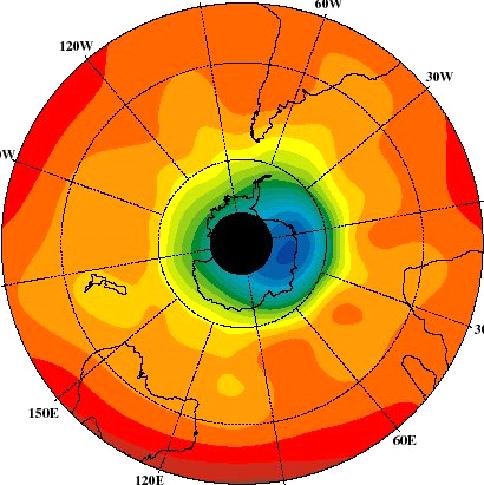First
Time Ozone Hole
Formed in the Arctic
In 2011, for the first time, ozone was destroyed over the Arctic
regions to an extent comparable to yearly losses in Antarctica.
Although Arctic temperatures are milder than the severe cold
of the Antarctic stratosphere, a comparable percentage of ozone
was destroyed in both polar regions this year. Writing in Nature,1 Gloria L. Manney and 28 co-authors
claim that a true “ozone hole” formed over the Northern
Hemisphere this year.
|
|

Picture above depicts the Ozone
Hole over Antarctica. From 1979 to 1997, total ozone levels
in the atmosphere declined 40% or more in the blue-toned region.
|
In the 1980s, scientists were stunned to discover that a “hole”
formed in the ozone layer of the stratosphere every spring over
Antarctica. They were quickly convinced that the newfound ozone
disappearance was real. Chlorine compounds were destroying the
natural ozone, and the only known source of chlorine was a class
of man-made chemicals called chlorofluorocarbons (CFCs), which
were manufactured as refrigerants and as propellants in aerosol
spray cans.
In the Antarctic stratosphere, temperatures routinely plummet
to an extremely frigid –80°C by the end of winter. When
that happens, water vapor and nitric acid condense into polar
stratospheric clouds from 15 to 30 km above the ground. The cloud
particles offer surfaces on which chemical reactions, involving
chlorine, can be catalyzed. These reactions decompose ozone in
the atmosphere.
Scientists were not sure that an ozone hole would form in the
Arctic, since the Arctic stratosphere rarely gets cold enough
for these clouds to form, although they did observe that some
ozone was lost every year. Manney’s team reports that the
whirl of air around the Arctic known as the “polar vortex”
was unusually cold and isolated from surrounding regions for four
months ending in March 2011. That isolation was enough to destroy
most of the ozone there by March—which was unprecedented
in the Northern Hemisphere. |
|
While the greenhouse effect warms the lower atmosphere, it actually
cools the stratosphere. That is because greenhouse gases intercept
some of the heat radiation that Earth emits to outer space. That
energy warms the lower layers, but what the low layers gain, the
upper layers lose. So the stratosphere has been steadily cooling
for several decades precisely because the greenhouse effect has
become stronger.
Thus, with ever more global warming at the surface, a very cold
stratosphere like the one in 2011 may occur more often, which
would favor future Arctic ozone holes. With some concern, the
authors conclude that an ozone hole in the north “could
exacerbate biological risks from increased exposure” to
ultraviolet radiation, especially when the polar vortex shifts
over populated middle latitudes, as it did last April.
Citation:
1. “Unprecedented
Arctic ozone loss in 2011” by Gloria L. Manney and 28
others (2011). Nature, vol. 478, 469–475, 27 Oct.
2011, doi:10.1038/nature10556.
|
|

